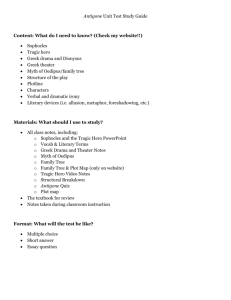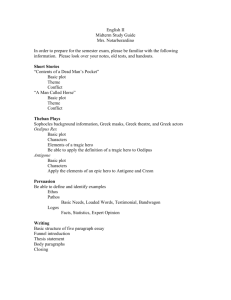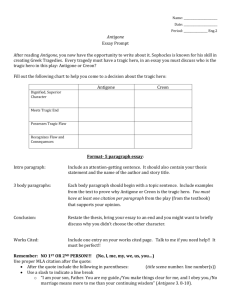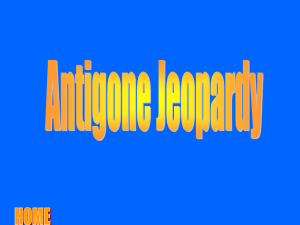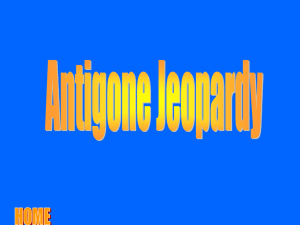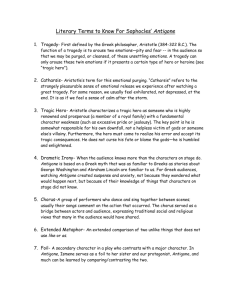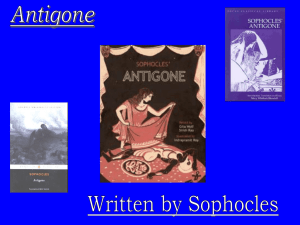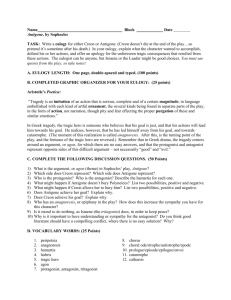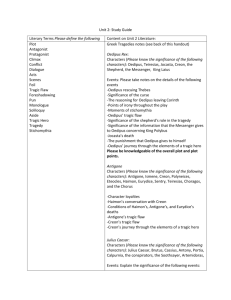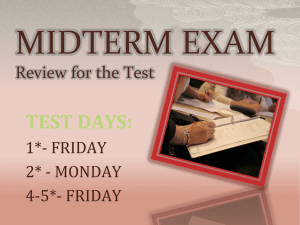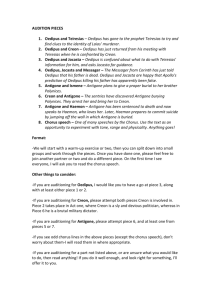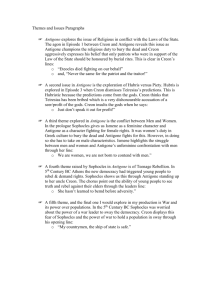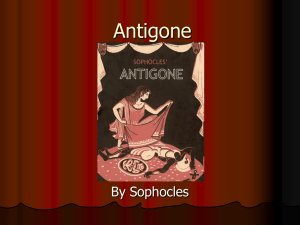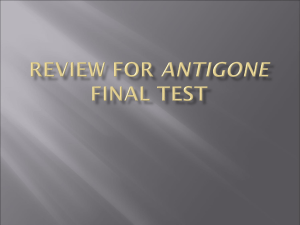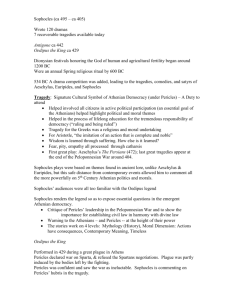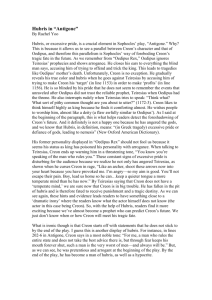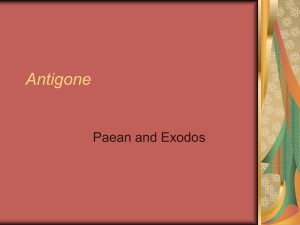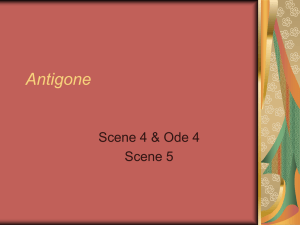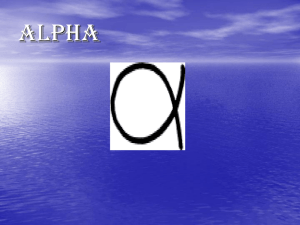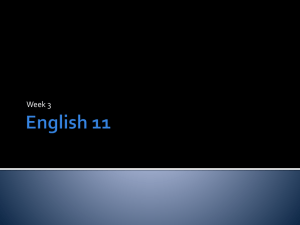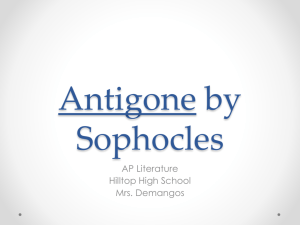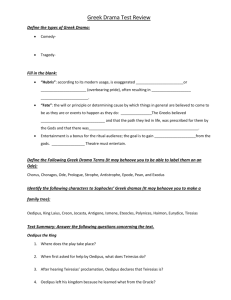Antigone - The Koller Kingdom
advertisement
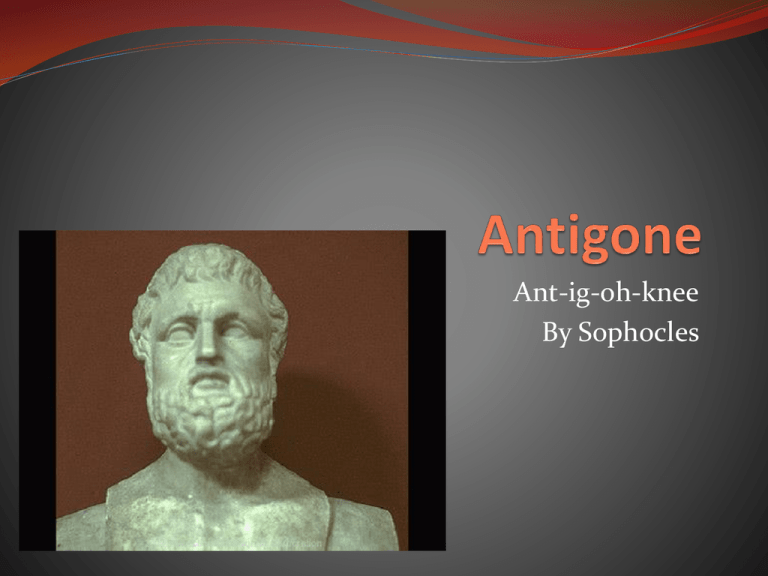
Ant-ig-oh-knee By Sophocles Tear & Share Group brainstorming using the "Tear and Share” four questions are: 1. What is a relationship? 2. What obstacles stand in the way of relationships' enduring? 3. In times of adversity, do family bonds/relationships help us survive? 4. Does it take courage to sustain a relationship? Tear & Share 1. Fold Paper into 4’s & number 1, 2, 3, 4 Answer the 4 questions independently on your squares (brief response) Fold the paper into 4 squares & tear into 4’s. Someone take all the 1s, 2s, 3s, 4s 1s, 2s,3s, 4s join up Write a synthesis that summarizes all the ideas of the group. Share summaries as a group. Record your summaries on the board. Sophocles (Sawf-oh-kleez) The Greek tragic playwright, Sophocles (ca.496-406 B.C.) Contemporaries Aeschylus and Euripides One of the greatest dramatists of the ancient world. Masterpieces are Oedipus Rex, Oedipus at Colonus, Antigone, and Electra. Respected public figure in Athens, served as a priest and a general under Pericles in the Samian War of 440 B.C. Composed about 123 dramas in all, and won many dramatic prizes after 468 B.C. Theatrical innovations were the addition of a third actor, a larger chorus, the introduction of painted scenery, and an abandonment of the trilogy style that had been used in composing self-contained tragedies. Greek drama Drama evolved from religious festivals in honor of Dionysus, the god of wine three actors would rotate to play all the speaking parts and thus the importance of masks. Video Universal Themes in Literature – about 25 min. Rank your loyalties Rank the people you are loyal to from 1 – most loyal to least. Family, friends, school, country, etc. Why do we rank them differently? Elements of classical drama Tragedy: downfall of a dignified, superior character This character is the tragic hero. Tragic hero has (usually) archetypal elements. Tragic flaw is the hero’s error or weakness. Chorus – group of actors who comment on the action in the play. Represents “the people” Leader is choragus. Dramatic irony – audience’s awareness of things the characters do not know – is often present in classical drama. Our hero must: Have a tragic flaw The punishment must exceed the crime The character must understand and accept their fall Elements of Classical Drama cont’d Usually ends in a catastrophe – disastrous conclusion. At the end (exodus) Hubris – extreme pride or arrogance. Seen in the hero. Usually leads to fall. Hubris was one of the worst traits in Greek life. Motifs – repeating elements that advance the plot & illustrate the theme. Allusions to gods & rituals = allusion is a reference. Close Reading Page 1059 – Oedipus 5 HOME groups of 5 people in each group (block 2 – extra people can join, if necessary. 4th – 5 groups of 4) As a group, answer YOUR question (question 1, 2, 3, 4 or 5). Then, split off and join someone from each group and jot down your answers for 1-5. Reconvene with HOME group. Go thru answers 1 at a time and everyone write them down. Share your discussion results. Focus for Reading Analyze the CONFLICT in the story. Conflict can come in four forms: Person – against – self Person – against – person Person – against – nature Person – against – society Tragic flaw or fate Debate 4 groups 2 groups on each side: Creon’s pride Antigone’s stubbornness Which led to the tragic events in Antigone? Find evidence for your side (line #s to support!) as well as counterarguments you anticipate the other side will bring up. Ode 2 What punishment has Creon just ordered for Antigone & Ismene? 2. How does the sea imagery in the first verse of the ode underscore the idea that Antigone and Ismene are doomed? 3. The first ½ of the poem refers to the house of Oedipus, the second ½ to the house of Creon. What does the poem suggest about how the 2 houses are linked? 1. Ode 3 According to the 1st verse, whom does Love conquer and destroy? (6-8) 2. According to the 2nd verse, what does love do to a just man? (9-13) 1. Ode 4 This ode links both Creon & Antigone to tragic mythological figures. 1. How is the story of Danae, described in the first verse, similar to the Oedipus myth? (1-5) 2. Which figure f/the play is like King Dryas’ son, described in the second verse? (lines 10-18) 3. How is Antigone like King Phineus’ first wife, whose story is told in the last two verses? (lines 19-34) Scene 5, 1. What is Creon’s initial attitude toward Teiresias (3-7) 2. Why is he indebted to Teiresias? Lines 7, 64 3. Why has Teiresias come to Creon now? (8-40)? Hurricane Katrina Look at article.. Who is to blame? Hurricane Katrina video on Disc. ED.
